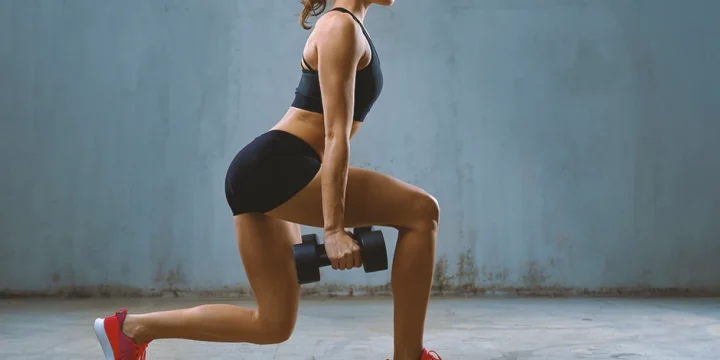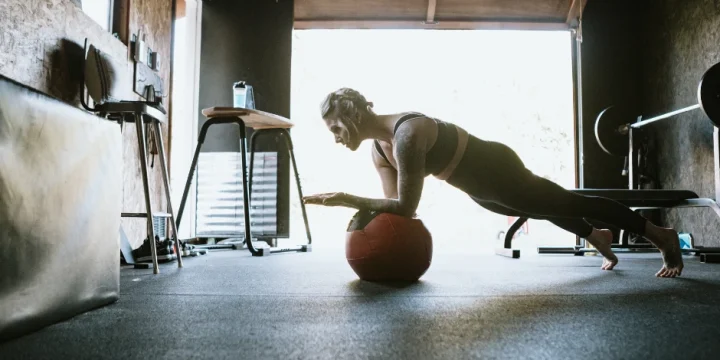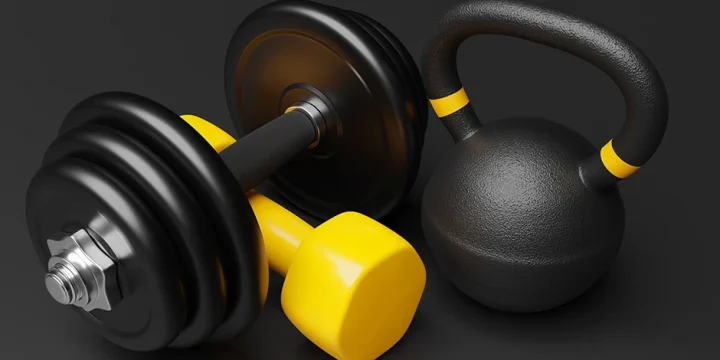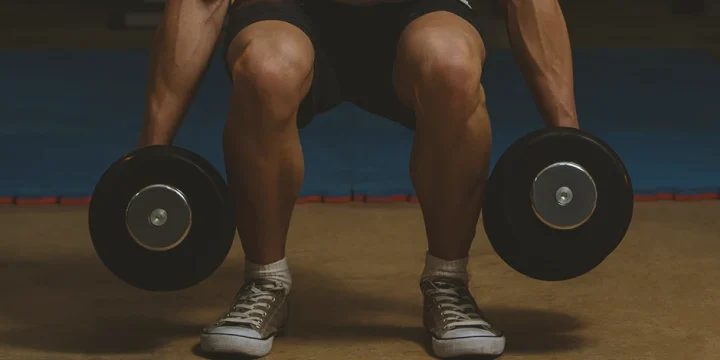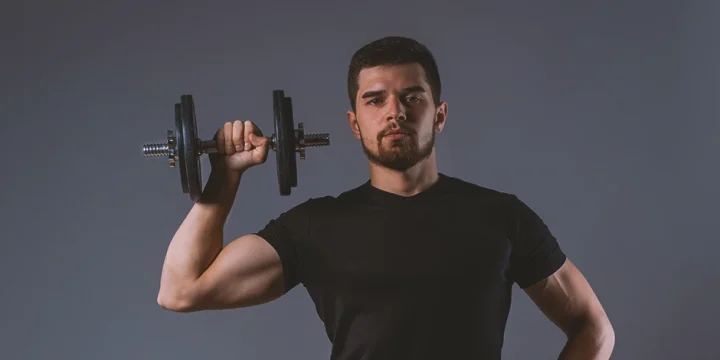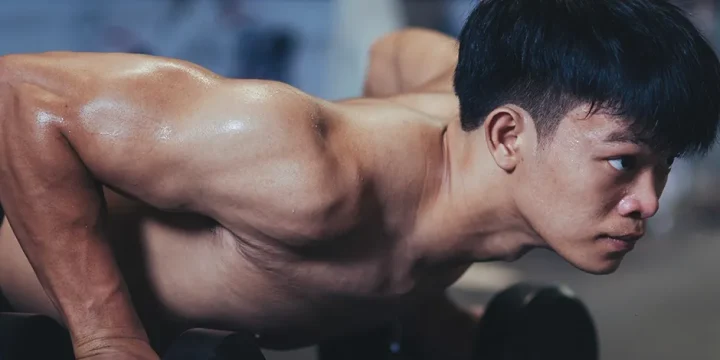My fitness colleagues and I agree that full-body workouts are the way to burn fat, build muscle, and improve athleticism.
Where we sometimes differ is what equipment gives the best full-body workout.
After seeing dozens of clients achieve their fitness goals over the last decade, I can say, hands down, that nothing compares to the convenient, accessible dumbbell.
Let’s look at some of the best exercises to incorporate into dumbbell workouts.
Quick Summary
- To effectively target every muscle, the focus is on exercises like a squat with a bicep curl, forward lunge with tricep extension, reverse lunge with single arm front raise, burpee, close grip shoulder press sit-up, jumping lunge, overhead carry, front plank arm leg raise, iron cross, one-arm snatch, thruster, and bench press.
- The right dumbbell size should be chosen based on individual strength and fitness level, with lighter weights recommended for beginners.
- According to the International Journal of Exercise Science, full-body dumbbell workouts offer extensive benefits, enhancing muscle strength and overall fitness.
- In my opinion, full-body dumbbell workouts are incredibly versatile and beneficial, offering a balanced approach to fitness that suits a wide range of goals and abilities.
Best Full-Body Dumbbell Exercises

Performing the following exercises will create an effective, full-body dumbbell workout that targets the following:
- Quads
- Hamstrings
- Glutes
- Pec Major
- Deltoids
- Traps
- Lats
- Biceps
- Triceps
- Core
Training recovery involves resting muscles in between training sessions. You can aid short-term recovery (between sets) by alternating between upper and lower body exercises during your full-body workout [1].
Tailor your dumbbell routine to align with your specific fitness goals, whether it's building muscle, fat loss, increasing strength, or enhancing sports performance, by incorporating exercises that target these specific outcomes.
“If hypertrophy and/or strength is a priority goal (. . .) incorporate three-minute rest intervals between sets during multiple-set training sessions.”
- Len Kravitz, PhD
Squat with Bicep Curl
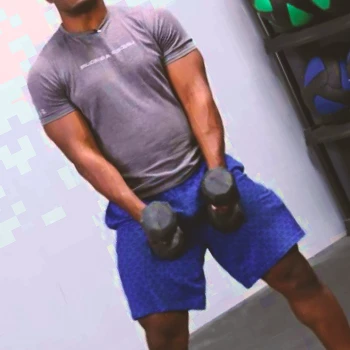
The dumbbell squat with bicep curl is an excellent exercise for all fitness levels due to its simple mechanics.
Muscles targeted include the quads, glutes, biceps, forearms, core, and back.
In my coaching experience, I've found the dumbbell squat with bicep curl to be a client favorite for its simplicity and effectiveness.
Here’s how to do it:
- Stand upright with a dumbbell in each hand.
- Lower into a squat position while simultaneously curling the dumbbells.
- Lower dumbbells back to a neutral grip position as you drive up from the heels back to the start.
- Repeat for the desired number of reps.
Forward Lunge with Tricep Extension
Dumbbell forward lunges with tricep extension work the legs, glutes, and triceps, effectively building balance and coordination while promoting core stability.
Here’s how to do it:
- Stand with feet hip-width apart, holding dumbbells.
- Press weights up overhead, then down to 90° elbow flexion behind the head.
- Step forward with the left foot and lunge until the legs form a 90-degree angle.
- Extend elbows and bring weights overhead.
- Lower the weights behind the head and press through the heel to return to standing.
- Complete on the opposite side for one rep.
- Repeat for the desired number of reps.
Related: Dumbbell Tricep Extensions: Technique, Form and Variations
Reverse Lunge with Single Arm Front Raise
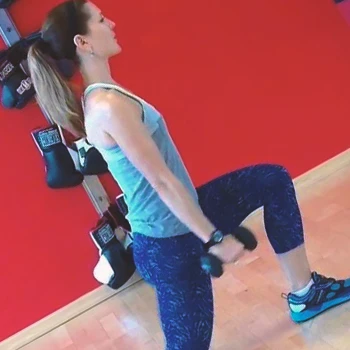
The dumbbell-reverse lunge with single arm front raise will increase your heart rate as it works the legs, glutes, front delts, and chest.
It is a single-leg/arm unilateral movement that demands core and back strength for stability and posture.
From my coaching sessions, the reverse lunge with single arm front raise has been a game-changer for clients aiming to intensify their cardio while working on multiple muscle groups.
Here’s how to do it:
- Stand with feet hip-width apart with dumbbells in a neutral grip and arms straight at your sides.
- Step back with one leg while performing a front raise on the opposite arm.
- Drive force from the heel of the planted foot to stand up.
- Slowly lower the dumbbell back to the side when standing.
- Repeat reps on each side, alternating which leg is stepping back and which arm is raising.
Burpee
The classic bodyweight burpee is tough enough, but add dumbbells, and you’ll challenge your strength, endurance, and fortitude.
Dumbbell burpees activate and challenge every muscle in the body while burning multiple calories.
I recommend starting this advanced burpee variation with a lighter weight to ensure you are keeping proper form and avoiding injury risk.
Here’s how to do dumbbell burpees:
- Stand with a dumbbell in each hand at your sides in a neutral position.
- Squat down, placing the dumbbells on the floor about shoulder-width apart.
- Immediately hop your feet back onto a plank.
- From the plank position, you can either perform a push-up or immediately hop back into the squat/deadlift position, then lift the dumbbell (while keeping your spine as straight as possible).
- As you come up, you explode off your feet, so you jump into the air with the dumbbells at your sides.
- Try to land as softly as possible, meaning land with knees slightly bent and not fully extended.
- Repeat for the desired number of reps.
Close Grip Shoulder Press Sit-Up
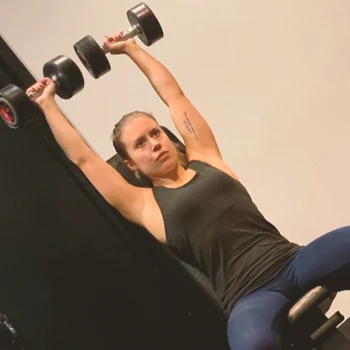
The dumbbell close grip shoulder press sit-up is an upper-body exercise that works the core, lower back, chest, shoulders, triceps, biceps, and upper back.
Because this is a more advanced exercise, build core strength with standard sit-ups and planks first, as these exercises can put too much pressure on the spine.
During my training sessions, the close grip shoulder press sit-up has been effective in strengthening the core and upper body simultaneously.
Here’s how to do this sit-up variant:
- Start in a sit-up position with your feet held down.
- Hold dumbbells on the chest and upper abs.
- Simultaneously perform sit-ups and press dumbbells overhead as you reach the top of the movement.
- Lower your back slowly while bringing dumbbells down in a controlled manner.
- Keep your core engaged and avoid flaring your elbows out.
- Repeat for the desired number of reps.
Also read: How To Do Close-Grip Bench Press
Jumping Lunge
The jumping lunge is primarily a leg exercise that helps you burn calories due to its explosiveness.
It is an excellent example of whole-body training to incorporate into HIIT sessions.
Here’s how to do jumping lunges:
- Hold dumbbells in a neutral grip and step your right foot back into a split squat position.
- Lower right leg and then explode up into a jumping motion.
- Upon landing, alternate feet so the right is in front and the left is in back.
- Repeat for the duration of the set.
Overhead Carry
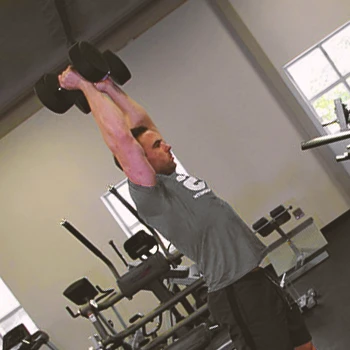
The dumbbell overhead carry is a total-body exercise that benefits strength, power, cardiovascular health, and endurance.
It works out the legs, core, traps, shoulders, upper chest, triceps, and entire back.
Overhead carries have consistently shown to enhance my clients' overall strength and endurance, as I've observed in our training sessions.
Here’s how to do it:
- Stand up straight with dumbbells held in a neutral grip.
- Press the dumbbells up overhead while maintaining a neutral grip.
- Walk slowly with control for 50–150 feet per set.
Front Plank Arm Leg Raise
This variant of the classic plank exercise is a demanding exercise requiring significant core strength and stability.
The front plank arm leg raise works muscles throughout the body, particularly the abs, obliques, lower back, shoulders, chest, triceps, upper back, hamstrings, and glutes.
For stability, I recommend using hex-shaped dumbbells over round ones.
Here’s how to do this plank variation:
- Begin in a high plank position with your hands on dumbbell handles using an overhand grip.
- Ensure the spine is straight and the hips are at the same level.
- Simultaneously raise right hand and left leg in a straight line parallel to the floor.
- Briefly hold before lowering back down.
- Return to starting position.
- Perform on the opposite side.
- Repeat for the desired number of reps.
Iron Cross
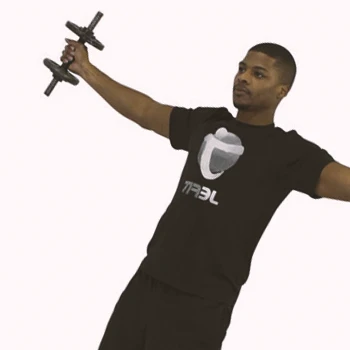
The iron cross is a whole-body dumbbell exercise targeting the quads, glutes, shoulders, and chest while using the back and core to stabilize the movement during exercise.
From my training experience, the iron cross has been an all-encompassing exercise that effectively targets multiple muscle groups.
Here’s how to do it:
- Stand with your feet shoulder-width apart and two dumbbells held in a neutral grip.
- Squat down and raise the dumbbells up and forward, keeping arms aligned with shoulders.
- Rise from the squat, pulling the dumbbells away from each other with arms extended to sides at shoulder level.
- Squat back down, rotating dumbbells back to your centerline.
- Squat up and rotate them to the sides again, keeping dumbbells at shoulder height with arms extended throughout the exercise.
- Repeat for the desired number of reps.
One-Arm Snatch
The dumbbell snatch is an exercise to increase full-body power and strength, especially for the quads, back, and shoulder muscles.
Being a single-arm movement, it also engages the core to keep the body from leaning to the working side.
Here’s how to do it:
- Grasp a dumbbell with an overhand grip in the left hand.
- Stand with your feet shoulder-distance apart.
- Squat down until the dumbbell rests on the floor between your feet, and align your shoulder with it.
- Pull the dumbbell up explosively while extending your knees and hips.
- Bend the knee as weight reaches overhead and drive up from heels to a fully standing position with the left arm extended.
- Carefully lower the weight back down to the starting position.
- Repeat for the desired number of reps.
“The dumbbell snatch is a full-body workout that activates multiple upper and lower body muscle groups, such as your glutes, quadriceps, upper back muscles, and core.”
- Katey Davidson, MScFN, RD, CPT
Thruster

The dumbbell thruster is an effective total-body exercise that works almost all muscles, but you will feel it in your quads, glutes, core, and shoulders.
The thruster has been a key exercise in my training programs for comprehensive muscle engagement, as I've observed with my clients.
Here’s how to do dumbbell thrusters:
- Stand with feet apart, holding dumbbells in a neutral grip at shoulder level.
- Squat down and maintain good form as you go as low as possible.
- Drive up from heels while pressing dumbbells overhead, rotating palms forward at the top.
- Lower weights back to a neutral grip at shoulder level for one complete rep.
- Repeat for the desired number of reps.
Bench Press
The dumbbell bench press requires engaging full-body muscles, including shoulders, upper arms, biceps, lats, pecs, traps, and delts.
Here’s how to do it:
- Start seated on a bench with medium-weight dumbbells in hand.
- Hold dumbbells above thighs and squeeze elbows tight to the ribs.
- Lie face up and open your elbows to the sides, forming a 45–70° angle with the torso.
- Press your feet flat against the floor, and keep your core tight.
- On an exhale, squeeze shoulder blades together, press dumbbells away from the chest, and straighten arms directly over the shoulders.
- On inhalation, lower the dumbbells back to the starting position, just above the shoulders.
What Size Dumbbell For Full-Body Exercises?

What size dumbbell you should use for full-body exercises largely depends on your fitness and strength.
Additionally, the specific exercises you perform will determine how much weight to use.
In my years of coaching, I've advised beginners to start with lighter weights and gradually increase as their strength improves.
To maximize space and efficiency in your home workout, consider the use of adjustable dumbbells, which can be easily modified for a wide range of exercises, eliminating the need for multiple sets of fixed-weight dumbbells.
Benefits
There are many benefits to implementing full-body dumbbell workouts into your routine, according to the International Journal of Exercise Science [2].
From my coaching experience, clients have effectively burned more calories and achieved fat loss through complex, full-body exercises.
These include:
- Complex, full-body, and compound exercises help burn more calories for fat loss.
- Intramuscular coordination leads to better athleticism.
- A higher heart rate has cardiovascular health benefits.
- An increased range of motion improves flexibility and mobility.
- Heavy loads can improve strength and muscle mass.
- An increase in hormones like testosterone provides additional muscle-building benefits.
FAQs
Can You Lose Body Fat with Dumbbells?
Yes, you can lose body fat with dumbbells. They offer a convenient and versatile way to burn calories and build muscle. With the correct exercise and weight, you can reach your desired body composition and sustain it over the long term.
How Long Should a Full-Body Dumbbell Workout Be?
A full-body dumbbell workout should take about 45–60 minutes based on three sets of ten reps of 8–10 exercises, resting up to 60 seconds between sets.
References:
- https://www.unm.edu/~lkravitz/Article%20folder/recoveryUNM.html
- https://www.ncbi.nlm.nih.gov/pmc/articles/PMC4836564/
About The Author
You May Also Like
